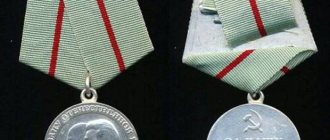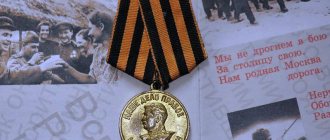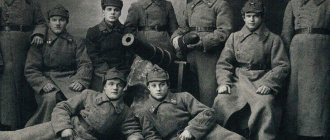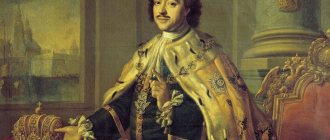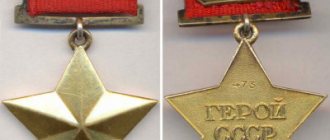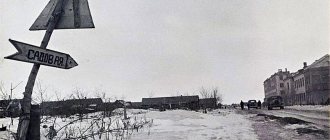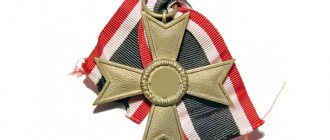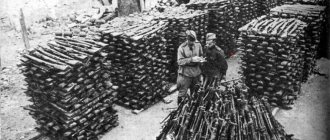During the period of hostilities 06.22.1941 - 05.9.1945, the system of awarding Red Army soldiers for their exploits included 33 orders and medals of the Great Patriotic War, of which 12 orders and 21 medals. Most of these awards appeared during wartime.
In the initial period of the war, soldiers and officers were awarded three orders and three medals. These awards appeared in the Soviet Union starting with the Civil War and in subsequent years. In this article we will not describe in detail the statutes of the awards, that is, what they were awarded for. There are a lot of such materials on the Internet. We want to reflect the history of the appearance of awards in chronological order during the period of hostilities of the Great Patriotic War. Descriptions of the feats performed by warriors who have earned the appropriate awards can be found in the “Veteran’s Wall” section of our website. In this section you can familiarize yourself in detail with deciphered descriptions of feats from official award documents posted on the “Feat of the People” website.
The order of Lenin
was the highest order of the Great Patriotic War, made of platinum and gold. In the initial period of the war, it was made without an order block. And from June 19, 1943, it was already produced with a pentagonal order block. At the same time, the old awards were to be replaced with orders of a new type. True, most of them were replaced after the end of the Great Patriotic War. The materials that formed the basis of the award were gold and platinum. A bas-relief with Lenin's profile was made from platinum. An interesting fact is that at the beginning of the war the image of the Order of Lenin was supposed to be placed on guards banners. But this project was never approved.
Order of the Red Banner
was the first Soviet order that appeared during the civil war in 1918. At that time, it was the highest award of the USSR until the establishment of the Order of Lenin. It was made of silver and was the only Soviet order, on the obverse of which a number was indicated, indicating the number of times the recipient received it. The shield with the number was placed on the wreath under the ribbon.
Order of the Red Star
was established on April 6, 1930. It was attached to clothing using a threaded pin and nut and was made of silver. The five-pointed star was covered with red enamel. During the war, two varieties of it were awarded, manufactured at the Moscow Mint and the Leningrad Mint (for No. 24417 - 28750) after the evacuation of the latter to Krasnokamsk. Externally, the varieties of the order differed in the images of the figures of the Red Army, and technologically in the way the medallion was attached. At the evacuated mint, the medallion was secured with three rivets, which could be seen on the reverse of the award, and on the order of another mint, the medallion was secured by soldering.
Medal "Gold Star"
was awarded as a badge of honor for the title of Hero of the Soviet Union. The title itself was established on April 16, 1934, and the medal on August 1, 1939. When conferring the first title of Hero of the Soviet Union, the award was made with the Order of Lenin and the Gold Star medal. For the second time and subsequent conferrals of the title, the Order of Lenin was no longer awarded, only a medal was awarded. The medal was made of 950 gold. Initially, the inscription “Hero of the SS” was supposed to be on the obverse of the medal. However, already on October 16, 1939, by decree of the Presidium of the Supreme Soviet of the USSR, changes were made, and the inscription was placed on the reverse and replaced with “Hero of the USSR”, due to associations with the Nazi SS Guard. So not a single medal with a dubious inscription was awarded.
Medal of Honor"
awarded for personal courage shown in battle. The medal was also awarded to fighters from penal units. Until June 19, 1943, it was produced on a rectangular block with a pin and nut, and after June 19 on a standard pentagonal block. The medal was made of 925 silver. The obverse featured a simplified image of a five-turret T-35 tank and I-16 fighters.
Medal "For Military Merit"
was established on October 17, 1938 and was awarded for skillful actions in battle that contributed to the solution of the tasks assigned to the military unit. The medal was made of 925 sterling silver. At first, the medal was made with a rectangular block covered with a red ribbon, and from mid-1943 with a standard pentagonal one. During the Great Patriotic War, this medal was also awarded to civilians, for example, for extinguishing incendiary bombs that the Wehrmacht dropped on our industrial facilities and cities.
Orders and medals of the Great Patriotic War - awards of 1942.
In 1942, four orders and four medals were established.
Order of the Patriotic War
was the first military decoration to appear during the war with Nazi Germany. And this was the first order that had a division into degrees - I and II. The Order of the 2nd degree was made of silver and covered with enamel, and for the Order of the 1st degree the star, covered with red enamel, was made of silver, the radiant star with a rifle and saber was made of 583 gold, the sickle and hammer were also made of gold. Until June 1943, the Order of the Patriotic War was made with a rectangular block, and later was issued without a block with a pin.
In 1942, three more military orders appeared in the award system, the most senior of them being the Order of Suvorov, then the Order of Kutuzov, and the junior Order of Alexander Nevsky. All of them were intended to reward the command staff of the Red Army for skillful leadership and successful actions of the led units.
Order of Alexander Nevsky
originally intended for commanders of military units from platoon to regiment. Since no lifetime images of the prince were preserved, a portrait of actor Nikolai Cherkasov, who played the role of Alexander Nevsky in the film of the same name, was placed on the obverse. The order was made of silver.
Order of Kutuzov
had I and II degrees, and in 1943 the rank of the order was expanded to III. According to the statute of military orders, such awards were awarded not in order of award from a lower order to a higher one, but in accordance with command positions. The third degree of the order was awarded to commanders from company to regiment. The second is the commanders of corps, divisions and brigades, and the first is the commanders of armies and fronts. Orders of the 1st degree were issued in gold, and junior ones in silver.
Order of Suvorov
originally had three degrees. The principles of awarding them were the same as those of the Order of Kutuzov. At the same time, the Order of Suvorov was considered the senior order. Sometimes the unit commander received the Order of Suvorov for a successful operation, and his deputy or chief of staff received the Order of Kutuzov of the same degree. The Order of Suvorov of the third degree was made of silver, the second - of gold, and the first - of platinum.
On December 22, 1942, medals “For the Defense of Stalingrad”, “For the Defense of Leningrad”, “For the Defense of Odessa”, “For the Defense of Sevastopol”
. These medals were awarded to military personnel and civilians who took part in the defense of these cities, respectively. The medals were made of brass and were worn on a pentagonal block. The medal "For the Defense of Leningrad" is mentioned in the statute of a foreign award. Citizens of Israel who were awarded the medal “For the Defense of Leningrad” have the right to receive the Israeli medal “Fighter against Nazism”.
Presentation of the Order for heroism in pre-war times
Test pilots who carried out flights and repairs of aircraft in the air earned recognition, for which they received the Order of the Red Star. In this way, military personnel who did not perform any feats as part of hostilities, but distinguished themselves by heroic deeds performed for the country in peacetime, were awarded. An excellent example: pilot Vykosa and navigator Erenkov were able to repair the landing gear fastenings directly in the air during a winter flight. Erenkov climbed onto the wing of the plane, Vykosa held him with his hands without special devices. Thanks to the courage and heroism of the pilots, the damage was repaired and the flight ended successfully.
There was experience in presenting the order to medical workers. It was received by Pyotr Vasilyevich Mandryka, the head of the central hospital of the People's Commissariat, for exemplary leadership and competent management of medical treatment.
Orders and medals of the Great Patriotic War - awards of 1943.
In 1943, three new orders and a medal appeared.
Order of Bohdan Khmelnytsky
appeared on October 10, 1943 at the suggestion of Nikita Sergeevich Khrushchev, who was at that time a member of the Military Council of the 1st Ukrainian Front. This military order had three degrees and was awarded for the same merits as the Orders of Suvorov and Kutuzov, that is, for skillfully organized military operations and successful actions of entrusted units. The difference was that this order was awarded not only to the commanders of the Red Army, but also to the commanders of partisan detachments and units. The Order of Bohdan Khmelnitsky, III degree, could also be awarded to ordinary personnel if their actions contributed to the success of the unit as a whole. This was the only Soviet order, the inscription on which was made not in Russian, but in Ukrainian. The First Class Order was made entirely of gold. The II degree of the order had only a central circle made of gold, and the star was made of silver; the III degree order was made entirely of silver.
Order of Glory
was established on November 8, 1943, and had three degrees. It was awarded for personal bravery to privates and non-commissioned officers; in aviation, the Order of Glory was also awarded to junior lieutenants. The awards, as a rule, were made sequentially: first with the third, then with the second and then with the first degree. The Order of Glory, 1st degree, was made of 950 gold. The Order of Glory, II degree, is made of silver, but the circle with the image of the Kremlin was gilded. The Order of Glory, III degree, was made of silver.
Order "Victory"
- the highest military order, appeared simultaneously with the Order of Glory in 1943. It was awarded to particularly distinguished commanders. In total, there were 15 holders of the order at the end of the war, 5 of them were foreigners. The materials from which the order is made are platinum, gold, silver, five artificial rubies weighing 5 carats each, 174 small diamonds. A total of 22 orders were made, some of them were not awarded.
Medal "Partisan of the Patriotic War"
was established on February 2, 1943 and had two degrees. The first class medal was made of silver, the second class – from brass. The medal was awarded not only to Soviet partisans, but also to foreign citizens, anti-fascists who fought in Soviet partisan detachments. The largest medal award during the Great Patriotic War was made for the partisan operation “Concert” in September - November 1943. This operation preceded the offensive of Soviet troops. It was carried out by 193 partisan detachments of one hundred and twenty thousand people and consisted of a large-scale undermining of railway tracks, railway bridges and trains in an area about 900 kilometers along the front and over 400 kilometers in depth from the front line.
Awarding orders to aviation workers
In pre-war times, it was aviation industry workers, pilots, navigators and test engineers who most often received the Red Star as an award. So, for example, in 1933, mechanical engineers of the Air Force Aladinsky, Michugin, Gromov and others received the Order of the Red Star, dedicated to Aviation Day. Along with them, employees of military educational institutions that train personnel for the air force, and employees of the construction department involved in the creation of aviation equipment were awarded.
Among the awarded aviation industry workers was the name of the currently famous aircraft designer Andrei Nikolaevich Tupolev. The wording used to receive the order was as follows: “For the creation of a number of outstanding aircraft.” But soon the outstanding engineer suffered a setback, he was arrested, and all his awards were confiscated. Immediately before the war, Tupolev was released, rehabilitated and was able to return his awards. True, they had completely different numbers.
Orders and medals of the Great Patriotic War - awards of 1944.
In 1944, two orders and five medals were accepted for award.
3/03/1944, for the first time during the entire war, two orders were established specifically for awarding officers of the Navy: the Order of Nakhimov and the Order of Ushakov.
Order of Nakhimov
corresponded to the military leadership order of Kutuzov, had two degrees and was awarded for leadership of successful operations of the fleet or crews of ships and formations. The Order of Nakhimov, II degree, was made of silver. The Order of Nakhimov, 1st degree, consisted of silver and gold stars, a gold medallion and profile of Nakhimov, five rubies in the rays of a silver star.
Order of Ushakov
fully corresponded to the military order of Suvorov and, unlike the Order of Nakhimov, was awarded for successful active operations at sea, as a result of which victory was won over a numerically superior enemy. The order of the second degree was made of silver and gold, the first degree - silver, gold and platinum.
From March 3, 1944, new medals were intended to award privates, sergeants and midshipmen: Nakhimov and Ushakov. These medals were awarded to employees of the Navy and maritime border units.
Nakhimov Medal
awarded for actions that contributed to the successful solution of combat missions assigned to military units and ships. The medal was made of bronze.
Ushakov Medal
was awarded for personal courage and was made of 925 sterling silver.
On May 1, 1944, the medal “For the Defense of Moscow” and the medal “For the Defense of the Caucasus”
, and on December 5 of the same year
the medal “For the Defense of the Soviet Arctic”
. The delivery was made to military personnel and civilians who took part in the defense of the respective territories. The period from June 22, 1941 to November 1944 was considered the period of defense of the Soviet Arctic. All medals were made of brass.
Assessing the merits of other industries
Along with the aviation industry, the extraction of precious materials played a major role at that time. The order was awarded to the head of the gold mining industry department, Serebrovsky, for the fact that, under his strict leadership, the enterprise exceeded the metal mining program for 1934.
In the next two years, workers in the missile and tank production were appreciated. The orders were received by technicians and tank drivers who distinguished themselves by excellent combat skills and successful development of political training. For example, tanker Oshkaderov received an award for 800 hours of trouble-free operation of a tank.
Among others, newspaper employees received Red Stars. The team of the newspaper of the same name was awarded in the first rows. He was recognized for his special achievements in providing training and fleet support. Later, “Red Star” received other medals.
Medals of the Great Patriotic War - awards of 1945.
And finally, in 1945, the last year of the Great Patriotic War, eight medals were included in the awards system.
Medal "For victory over Germany in the Great Patriotic War of 1941-1945"
was established on May 9, 1945. It was awarded to military personnel and civilians who served in the army or ensured victory through their work in military districts. The medal was awarded to about 15 million people, including foreign military personnel. This medal was made of brass.
The last seven medals of the Great Patriotic War were established by two different decrees of the Presidium of the Supreme Soviet of the USSR dated June 9, 1945. One decree established medals for the liberation of European capitals: the medal “For the Liberation of Warsaw”, the medal “For the Liberation of Prague”, the medal “For the Liberation of Belgrade”
.
Another decree established medals for the capture of enemy cities: medal “For the Capture of Budapest”, medal “For the Capture of Koenigsberg”, medal “For the Capture of Vienna”, medal “For the Capture of Berlin”
.
The medal “For the Capture of Königsberg” was the only one that was not awarded for the capture or liberation of the capital. All medals were made of brass.
Here is a brief summary of what we wanted to say about the awards, which are the orders and medals of the Great Patriotic War. If you want to familiarize yourself in detail with the statutes of each of the awards, then they are officially defined by the Decrees of the Presidium of the Supreme Soviet of the USSR. Full texts of decrees are available in legal reference systems.
USSR medals for labor achievements.
After the end of the war and until 1991, another 28 medals were added to the USSR award system. During the early years of peace, several awards were created to recognize efforts to rebuild war-torn industries. These are medals such as “For the restoration of coal mines of Donbass”, “For the restoration of ferrous metallurgy enterprises of the south”, etc. Later, already in the Brezhnev era, the following series of “labor” medals was established: “For the development of virgin lands”, “For the construction of Lake Baikal” -Amur Mainline" and the highest labor award - the medal "Veteran of Labor".
The award system of medals for military merits developed little in peacetime. During this period, mainly numerous anniversary medals were established: in honor of the twenty, thirty, and fortieth anniversary of the Victory and the anniversaries of the Armed Forces of the USSR. The missions of Soviet officers to hot spots of the post-war period were marked mainly by the medals “For Military Merit” and “For Courage” established back in 1938. These awards have become the most common medals in Afghanistan. Shortly before the start of the Afghan War, the medal “For Distinction in Military Service” was also introduced into the award system, but it was given, practically, simply for the successful fulfillment by officers of their direct duties: for missile launches, organization of educational work, even for victories in departmental sports competitions, therefore the prestige of the award was low.
In 1991, the USSR ceased to exist, Soviet medals are no longer awarded, but this in no way detracts from the exploits and merits of the recipients of awards of that time: soldiers, officers, scientists, cultural figures and simply ordinary workers who honestly did their work.
